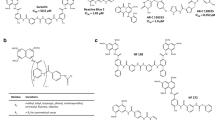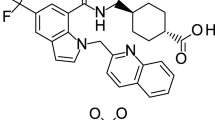Abstract
The aim of this study was to explore the effect of 0NO-54918-07, a stable prostacyclin analogue, on the current–voltage (IV) curve and the intracellular Ca2+ concentration [Ca2+]i of NG108-15 neuroblastoma × glioma hybrid cells. The IV curve was measured with ramp pulses from −70 to 0 mV, and [Ca2+]i was determined with Fura 2. Bath application of 0.2 μM ONO-54918-07 reversibly increased the holding current at −70 mV by −81.1 ± 14.8 pA (mean ± SEM, n = 35) and the slope of the IV curve between −70 and −50 mV by the factor 2.24 ± 0.24. The effect of 0.2 μM prostaglandin PGE1 was similar (ΔI hold = −96.1 ± 29.9 pA, g/g control = 2.72 ± 0.44, n = 9). ONO-54918-07 concentrations of 0.04, 2 and 6 μM were also effective. From the dose–response curve, the concentration for the half maximal effect was obtained as 0.054 μM. When cells did not respond to ONO-54918-07, an effect could sometimes be elicited by a ramp pulse or by a second ONO-54918-07 application 30–50 min after the first. The effect of ONO-54918-07 was not affected by pre-treatment with the EP1 antagonists ONO-8713 or SC-51089. However, a 14–40 min pre-treatment with 1 μM RO3244794, a selective prostacyclin receptor (IP) antagonist, abolished the effect of 0.2 μM PGE1. The effect of 0.2 μM ONO-54918-07 vanished completely in the presence of 5 μM RO32446794. ONO-54918-07 and PGE1 produced a slow increase in [Ca2+]i that lasted at least 6 min. Δ[Ca2+]i induced by both substances reached approximately 12% of the peak Δ[Ca2+]i induced by application of bradykinin. In only a few cells, PGE1 produced a brief, transient rise of [Ca2+]i. Using reverse transcriptase polymerase chain reaction, a prominent expression of the IP was detected in NG108-15 cells. It is concluded that ONO-54918-07 mimics the effect of PGE1, supporting the notion that the PGE1 effect on NG108-15 cells is mediated by IP receptors.







Similar content being viewed by others
References
Adie EJ, Mullaney I, McKenzie FR, Milligan G (1992) Concurrent down-regulation of IP prostanoid receptors and the α-subunit of the stimulatory guanine-nucleotide-binding protein (GS) during prolonged exposure of neuroblastoma × glioma cells to prostanoid agonists. Biochem J 285:529–536
Aneiros E, Philipp S, Lis A, Freichel M, Cavalié A (2005) Mobilisation of Ca2+ signalling by Na+/Ca2+ exchangers in mast cells. J Immunol 174:119–130
Ben-Chaim Y, Tour O, Dascal N, Parnas I, Parnas H (2003) The M2 muscarinic G-protein-coupled receptor is voltage-sensitive. J Biol Chem 278:22482–22491
Ben-Chaim Y, Chanda B, Dascal N, Bezanilla F, Parnas I, Parnas H (2006) Movement of “gating charge” is coupled to ligand binding in a G-protein-coupled receptor. Nature 444:106–109
Bley KR, Bhattacharya A, Daniels DV, Gever J, Jahangir A, O’Yang C, Smith S, Srinivasan D, Ford APDW, Jett M-F (2006) RO1138452 and RO3244794: characterization of structurally distinct, potent and selective IP (prostacyclin) receptor antagonists. Br J Pharmacol 147:335–345
Clark K, Langeslag M, van Leeuwen B, Ran L, Ryazanov AG, Figdor CG, Moolenaar WH, Jalink K, van Leeuwen FN (2006) TRPM7, a novel regulator of actomyosin contractility and cell adhesion. EMBO J 25:290–301
Harlfinger S, Fork C, Lazar A, Schömig E, Gründemann D (2005) Are organic cation transporters capable of transporting prostaglandins? Naunyn-Schmiedeberg’s Arch Pharmacol 372:125–130
Inoue M, Rashid MH, Kawashima T, Matsumoto M, Maeda T, Kishioka S, Ueda H (2003) The algogenic-induced nociceptive flexion test in mice: studies on sensitivity of the test and stress on animals. Brain Res Bull 60:275–281
Langeslag M, Clark K, Moolenaar WH, van Leeuwen FN, Jalink K (2007) Activation of TRPM7 channels by PLC-coupled receptor agonists. J Biol Chem 282:232–239
Launay P, Fleig A, Perraud A-L, Scharenberg AM, Penner R, Kinet J-P (2002) TRPM4 is a Ca2+-activated nonselective cation channel mediating cell membrane depolarization. Cell 109:397–407
Masuda Y, Ochi Y, Ochi Y, Karasawa T, Hatano N, Kadokawa T, Okegawa T (1986) Protective effect of a new prostacyclin analogue OP-2507 against cerebral anoxia and edema in experimental animals. Eur J Pharmacol 123:335–344
Mathes C, Thompson SH (1995) The relationship between depletion of intracellular Ca2+ stores and activation of Ca2+ current by muscarinic receptors in neuroblastoma cells. J Gen Physiol 106:975–993
Matsuoka Y, Furuyashiki T, Bito H, Ushikubi F, Tanaka Y, Kobayashi T, Muro S, Satoh N, Kayahara T, Higashi M, Mizoguchi A, Shichi H, Fukuda Y, Nakao K, Narumiya S (2003) Impaired adrenocorticotropic hormone response to bacterial endotoxin in mice deficient in prostaglandin E receptor EP1 and EP3 subtypes. Proc Natl Acad Sci U S A 100:4132–4137
Meves H (2003) Prostaglandin E1 induces an inward current in voltage-clamped NG108-15 cells. Prostaglandins Other Lipid Mediat 71:265–276
Meves H (2005) The effect of prostaglandin E1 on ion currents of NG108-15 cells. Prostaglandins Other Lipid Mediat 76:117–132
Meves H (2006) The action of prostaglandins on ion channels. Current Neuropharmacol 4:41–57
Moriyama T, Higashi T, Togashi K, Iida T, Segi E, Sugimoto Y, Tominaga T, Narumiya S, Tominaga M (2005) Sensitization of TRPV1 by EP1and IP reveals peripheral nociceptive mechanism of prostaglandins. Mol Pain 1:3
Owsianik G, Talavera K, Voets T, Nilius B (2006) Permeation and selectivity of TRP channels. Annu Rev Physiol 68:685–717
Rashid MH, Inoue M, Bakoshi S, Ueda H (2003) Increased expression of vanilloid receptor 1 on myelinated primary afferent neurons contributes to the antihyperalgesic effect of capsaicin cream in diabetic neuropathic pain in mice. J Pharmacol Exp Ther 306:709–717
Reiser G, Cesar M, Binmöller F-J (1992) Bradykinin and muscarine induce Ca2+-dependent oscillations of membrane potential in rat glioma cells indicating a rhythmic Ca2+ release from internal stores: Thapsigargin and 2,5-Di (tert-butyl)-1,4-benzohydroquinone deplete InsP3-sensitive Ca2+ stores in glioma and in neuroblastoma–glioma hybrid cells. Exp Cell Res 202:440–449
Ross RA, Craib SJ, Stevenson LA, Pertwee RG, Henderson A, Toole J, Ellington HC (2002) Pharmacological characterization of the anandamide cyclooxygenase metabolite: prostaglandin E2 ethanolamide. J Pharmacol Exp Ther 301:900–907
Takemura H, Ohshika H, Yokosawa N, Oguma K, Thastrup O (1991) The thapsigargin-sensitive intracellular Ca2+ pool is more important in plasma membrane Ca2+ entry than the IP3-sensitive intracellular Ca2+ pool in neuronal cell lines. Biochem Biophys Res Commun 180:1518–1526
Takezawa R, Schmitz C, Demeuse P, Scharenberg AM, Penner R, Fleig A. (2004) Receptor-mediated regulation of the TRPM7 channel through its endogenous protein kinase domain. Proc Natl Acad Sci U S A 101:6009–6014
Tsuboi K, Sugimoto Y, Ichikawa A (2002) Prostanoid receptor subtypes. Prostaglandins Other Lipid Mediat 68–69:535–556
Wise H, Jones RL (1996) Focus on prostacyclin and its novel mimetics. Trends Pharmacol Sci 17:17–21
Yellen (1982) Single Ca2+-activated nonselective cation channels in neuroblastoma. Nature 296:357–359
Acknowledgements
The authors thank Ono Pharmaceutical (Osaka, Japan) for a generous gift of ONO-54918-07 and ONO-8713. They are also indebted to Roche Palo Alto LLC (Palo Alto, CA, USA) for a kind gift of RO3244794. The authors thank Dr. Mary-Frances Jett (Roche Palo Alto LLC) for critically reading the manuscript. They are grateful to Dr. M. Nirenberg (Bethesda, MD, USA) for providing the NG108-15 cells and to the Deutsche Forschungsgemeinschaft for financial support (SFB 530).
Author information
Authors and Affiliations
Corresponding author
Rights and permissions
About this article
Cite this article
Cavalié, A., Philipp, S.E. & Meves, H. ONO-54918-07, a stable prostacyclin analogue, mimics the effect of prostaglandin PGE1 on NG108-15 cells. Naunyn-Schmied Arch Pharmacol 376, 165–173 (2007). https://doi.org/10.1007/s00210-007-0186-2
Received:
Accepted:
Published:
Issue Date:
DOI: https://doi.org/10.1007/s00210-007-0186-2




